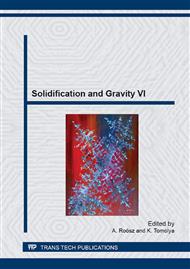p.193
p.199
p.205
p.211
p.217
p.223
p.229
p.235
p.241
Determination of Impurity Diffusion Coefficients in a Single Experimental Cycle
Abstract:
An experimental approach employing temperature and concentration gradients is presented that is suitable for determining impurity diffusion coefficients in a single experimental cycle. The Al-Cu system is used to illustrate the feasibility of the method. In a single phase α-Al solid solution, concentration gradients are generated by exposing a cylindrical sample to steep temperature gradients and by annealing until the initially formed mushy zone is re-solidified. The annealing is performed such that a symmetric, ramp shaped profile in the form of a roof is generated. The sample is then again exposed to a temperature gradient at somewhat lower temperatures for an extended time period. The symmetric profile then becomes asymmetric due to the varying diffusion coefficient along the sample. Information on the pre-exponential factor D0 and the activation energy for diffusion QD is retrieved from the asymmetry of the resulting concentration profile. The asymmetry becomes increasingly pronounced with longer diffusion times, yielding an increasing accuracy of the diffusion coefficients. The experimental approach is generally applicable to alloy systems with finite solubility.
Info:
Periodical:
Pages:
217-222
Citation:
Online since:
May 2014
Authors:
Price:
Сopyright:
© 2014 Trans Tech Publications Ltd. All Rights Reserved
Share:
Citation:


